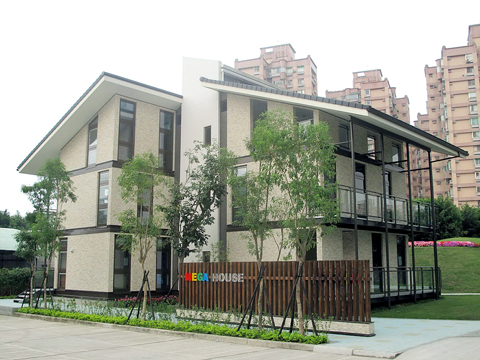Representatives from the National Taiwan University of Science and Technology unveiled a working model of a house with computerized temperature controls and other automations that promises to cut electricity bills by as much as 40 percent.
The “MEGA House” is a model of the most environmentally friendly building techniques at the nation’s disposal.
They added that the house contains computers that open and close windows, shutters and skylights according to preset temperatures inside and outside the building.

PHOTO COURTESY OF NATIONAL TAIWAN UNIVERSITY OF SCIENCE AND TECH
Cheng Min-yuan (鄭明淵), a professor at the university who was part of the design team, said the two-and-a-half-story building could resist earthquakes of up to magnitude seven on the Richter scale.
He said seven patents were filed by the research team during the design process.
Temperature is maintained using natural heating and cooling processes as opposed to air conditioning, researchers added. Cool air, which is pumped into the building using a pipe placed 4m below ground, interacts with hot air from a specially designed “solar chimney.”
The hot or cool air is maintained through an elaborate set of 18 specially layered windows that are not only self-cleaning, but also include panels for creating energy.
Another 48 solar panels are spread throughout the house to lessen its dependence on outside energy sources.
Both these designs are expected to result in a 20 percent to 40 percent overall energy saving.
To popularize the design, researchers also embedded radio-frequency identification technology into the building materials to cut construction time to four months and save about 40 percent in labor costs.
Using the technology, which allows workers to locate the correct placement of materials, base construction should only take three days.

Beijing could eventually see a full amphibious invasion of Taiwan as the only "prudent" way to bring about unification, the US Department of Defense said in a newly released annual report to Congress. The Pentagon's "Annual Report to Congress: Military and Security Developments Involving the People's Republic of China 2025," was in many ways similar to last year’s report but reorganized the analysis of the options China has to take over Taiwan. Generally, according to the report, Chinese leaders view the People's Liberation Army's (PLA) capabilities for a Taiwan campaign as improving, but they remain uncertain about its readiness to successfully seize

Taiwan is getting a day off on Christmas for the first time in 25 years. The change comes after opposition parties passed a law earlier this year to add or restore five public holidays, including Constitution Day, which falls on today, Dec. 25. The day marks the 1947 adoption of the constitution of the Republic of China, as the government in Taipei is formally known. Back then the Chinese Nationalist Party (KMT) governed China from Nanjing. When the KMT, now an opposition party in Taiwan, passed the legislation on holidays, it said that they would help “commemorate the history of national development.” That

HORROR STORIES: One victim recounted not realizing they had been stabbed and seeing people bleeding, while another recalled breaking down in tears after fleeing A man on Friday died after he tried to fight the knife-wielding suspect who went on a stabbing spree near two of Taipei’s busiest metro stations, Taipei Mayor Chiang Wan-an (蔣萬安) said. The 57-year-old man, identified by his family name, Yu (余), encountered the suspect at Exit M7 of Taipei Main Station and immediately tried to stop him, but was fatally wounded and later died, Chiang said, calling the incident “heartbreaking.” Yu’s family would receive at least NT$5 million (US$158,584) in compensation through the Taipei Rapid Transit Corp’s (TRTC) insurance coverage, he said after convening an emergency security response meeting yesterday morning. National

Taiwan has overtaken South Korea this year in per capita income for the first time in 23 years, IMF data showed. Per capita income is a nation’s GDP divided by the total population, used to compare average wealth levels across countries. Taiwan also beat Japan this year on per capita income, after surpassing it for the first time last year, US magazine Newsweek reported yesterday. Across Asia, Taiwan ranked fourth for per capita income at US$37,827 this year due to sustained economic growth, the report said. In the top three spots were Singapore, Macau and Hong Kong, it said. South